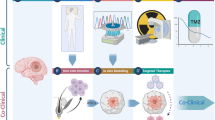Abstract
Personalized medicine has been helpful for drug development in diseases with single and relatively stable gene mutations. The benefit for complex solid tumours with heterogeneous and changing genetic profiles is less clear. Whether it is efficient to continue diverting resources from combined biological and pharmacological approaches to trial new and existing genetic ‘targeted therapies’ for brain tumours is unknown but of developing concern in resource constrained environments.
Similar content being viewed by others
References
Johnson DR, O’Neill BP (2012) Glioblastoma survival in the United States before and during the temozolomide era. J Neurooncol 107:359–364
http://www.nzheraldconz/hamilton-news/news/articlecfm?c_id=1503366&objectid=11418674
Soeda A, Hara A, Kunisada T, Yoshimura S, Iwama T, Park D (2015) The evidence of glioblastoma heterogeneity. Sci Reports 5:7979
Kim T, Kim J, Lee MG (2010) Inhibition of mutated BRAF in melanoma. N Engl J Med 363:2261; author reply 2261–2262
Milojkovic D, Apperley J (2009) Mechanisms of resistance to imatinib and second-generation tyrosine inhibitors in chronic myeloid leukemia. Clin Cancer Res 15:7519–7527
Thomas AA, Omuro A (2014) Current role of anti-angiogenic strategies for glioblastoma. Curr Treat Options Oncol 15:551–566
Addeo R, Perri F, Parlato C, Della Vittoria G (2014) ASCO 2013: bevacizumab and glioblastoma–a marriage dissolution? Curr Med Res Opin 30:1871–1873
Fay MF, Martin JH, Rose S (2014) New imaging techniques for more effective treatment in glioblastoma. Intern Med J 44:5–6
Gottlicher M, Minucci S, Zhu P et al (2001) Valproic acid defines a novel class of HDAC inhibitors inducing differentiation of transformed cells. EMBO J 20:6969–6978
Jung M, Velena A, Chen B, Petukhov PA, Kozikowski AP, Dritschilo A (2005) Novel HDAC inhibitors with radiosensitizing properties. Radiat Res 163:488–493
Galanis E, Jaeckle KA, Maurer MJ et al (2009) Phase II trial of vorinostat in recurrent glioblastoma multiforme: a north central cancer treatment group study. J Clin Oncol 27:2052–2058
Felix FH, Trompieri NM, de Araujo OL, da Trindade KM, Fontenele JB (2011) Potential role for valproate in the treatment of high–risk brain tumors of childhood-results from a retrospective observational cohort study. Pediatr Hematol Oncol 28:556–570
Weller M (2013) Are we ready for a randomized trial of valproic acid in newly diagnosed glioblastoma? Neuro-Oncol 15:809–810
Kerkhof M, Dielemans JC, van Breemen MS et al (2013) Effect of valproic acid on seizure control and on survival in patients with glioblastoma multiforme. Neuro-Oncol 15:961–967
Hosein AN, Lim YC, Day B et al (2015) The effect of valproic acid in combination with irradiation and temozolomide on primary human glioblastoma cells. J Neurooncol 122:263–271
Van Nifterik KA, Van den Berg J, Slotman BJ, Lafleur MV, Sminia P, Stalpers LJ (2012) Valproic acid sensitizes human glioma cells for temozolomide and gamma-radiation. J Neurooncol 107:61–67
Yao KC, Komata T, Kondo Y, Kanzawa T, Kondo S, Germano IM (2003) Molecular response of human glioblastoma multiforme cells to ionizing radiation: cell cycle arrest, modulation of the expression of cyclin-dependent kinase inhibitors, and autophagy. J Neurosurg 98:378–384
Conflict of interest
The authors declare that they have no conflict of interest.
Author information
Authors and Affiliations
Corresponding author
Rights and permissions
About this article
Cite this article
Fay, M., Head, R. & Martin, J. Where is the radiobiology and pharmacology research to improve outcomes in glioblastoma?. J Neurooncol 124, 1–3 (2015). https://doi.org/10.1007/s11060-015-1816-z
Received:
Accepted:
Published:
Issue Date:
DOI: https://doi.org/10.1007/s11060-015-1816-z




